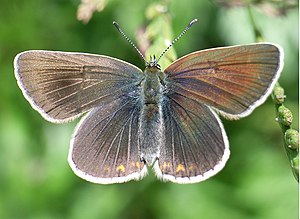Blue cranesbill
| Blue cranesbill | ||||||||||||
|---|---|---|---|---|---|---|---|---|---|---|---|---|

Blue Cranesbill ( Eumedonia eumedon ) |
||||||||||||
| Systematics | ||||||||||||
|
||||||||||||
| Scientific name | ||||||||||||
| Eumedonia eumedon | ||||||||||||
| ( Esper , 1780) |
The plebejus eumedon or Black Brown Bluebird ( Eumedonia eumedon ) is a butterfly ( butterfly ) from the family of Gossamer (Lycaenidae).
features
The moths reach a wingspan of 26 to 30 millimeters. The upper sides of the wings are dark brown in both sexes, the females also usually have small, orange-colored spots on the inner sides of the hind wings. The underside of the wing is light gray-brown and has orange spots on the edge, further inside there are black spots with a white border and a conspicuous, white longitudinal wipe.
The caterpillars are about 15 millimeters long. They are light green, but sometimes have reddish side bands. They have short, translucent white hair.
Synonyms
- Plebejus eumedon often falsely also Plebeius eumedon written
- Eumedonia eumedon
- Lycaena eumedon
- Eumedonia chiron
- Aricia eumedon
- Polyommatus eumedon
Occurrence
The blue cranesbill occurs in Central Europe, especially in the south and east. In Germany it is absent in the north, it is currently still found in Bavaria, Baden-Württemberg and Rhineland-Palatinate. It is also occasionally represented in parts of southern Europe and in Turkey . To the east, the distribution area extends over Mongolia to the Altai Mountains . The species lives in wet meadows and wet forest clearings as well as in dry and warm areas such as z. B. on the edges of steppe heather forests. The species is very rare in Germany. In Rhineland-Palatinate, the species is endangered.
Way of life
The moths are very faithful to their location and sometimes live in large numbers together on just a few square meters around their forage plants. The moths also feed on the cranesbill plants, they suck the nectar of their flowers.
Flight and caterpillar times
The moths fly regionally in one generation from the end of May, otherwise in June and July. The young caterpillars live very hidden in the seed pods from June to July. At the latest in August they leave the feeding plants to overwinter until March of the following year. After overwintering from April to May, they live again on the feeding plants.
Food of the caterpillars
The caterpillars feed differently depending on their habitat. In wetlands they feed on the swamp cranesbill ( Geranium palustre ), in dry biotopes on the blood-red cranesbill ( Geranium sanguineum ), but they are sometimes also found on other cranesbill species , such as the forest cranesbill ( Geranium sylvaticum ), the bulbous cranesbill ( Geranium tuberosum) ), Meadow cranesbill ( Geranium pratense ), gray cranesbill ( Geranium cinereum ).
development
The females lay their flattened, white eggs individually on the inside of the flowers on their pistil. The caterpillars feed after hatching in the ovary and eat the ovules of plants. After the second moult, they descend to the ground and overwinter at the foot of the plants. In spring they eat the leaves of the plants. They typically eat the petiole, the leaf of which then bends downwards due to the rapid withering. The caterpillar hides under this "umbrella". It is mostly accompanied by ants . The ants feed on the sweet excretions of a special nectar gland, which is located on the back of the caterpillars' back. In return, the ants protect the caterpillars from smaller enemies.
Hazard and protection
- Red list FRG: 2 (endangered)
swell
- ↑ Determination aid of the Lepiforum: Eumedonia Eumedon. Retrieved July 23, 2020 .
- ↑ a b c d e f Heiko Bellmann : The new Kosmos butterfly guide, butterflies, caterpillars and forage plants . Franckh-Kosmos, Stuttgart 2003, ISBN 3-440-09330-1 , p. 152 .
- ↑ Plebejus Kluk, 1802 is in the Official Lists and Indexes of Names in Zoology as a valid name for this genus PDF
- ↑ a b c d Manfred Koch : We determine butterflies. Volume 1: Butterfly. 4th enlarged edition. Neumann, Radebeul / Berlin 1966, DNB 457244224 .
- ↑ a b c d e f Tagfalter. 2. Special part: Satyridae, Libytheidae, Lycaenidae, Hesperiidae . In: Günter Ebert, Erwin Rennwald (eds.): The butterflies of Baden-Württemberg . 1st edition. tape 2 . Ulmer, Stuttgart (Hohenheim) 1991, ISBN 3-8001-3459-4 .
- ↑ a b Aricia eumedon at Fauna Europaea. Retrieved March 4, 2011
- ↑ a b Tom Tolman, Richard Lewington: The butterflies of Europe and Northwest Africa . Franckh-Kosmos, Stuttgart 1998, ISBN 3-440-07573-7 , p. 93 .
- ↑ W. Duering: styles Portrait of the pantograph-Bläulings in Rhineland-Palatinate. (PDF) In: Butterfly in Rhineland-Palatinate. BUND RLP, October 13, 2019, accessed on February 11, 2020 .
- ↑ Federal Agency for Nature Conservation (Ed.): Red List of Endangered Animals in Germany . Landwirtschaftsverlag, Münster 1998, ISBN 3-89624-110-9 .


